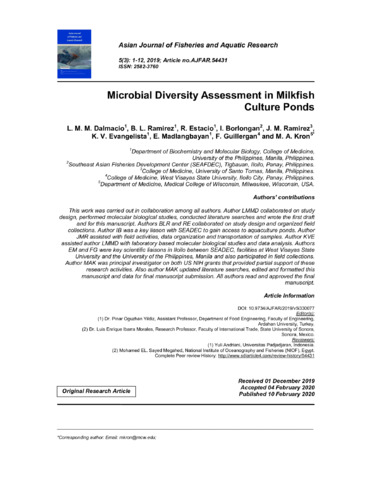Microbial diversity assessment in milkfish culture ponds

Associated URL
journalajfar.comDate
2020-02Author
Page views
314Metadata
Show full item recordCited times in Scopus
Share
Abstract
Aims: To determine bacterial diversity in milkfish culture ponds that contain different life-cycle stages of the milkfish (pond A: fry, pond B: juveniles and pond C: adults) by DNA sequence analysis of organisms and compare that microbial diversity to organisms found in soil adjacent to the ponds.
Study Design: Comparative metagenomic study of aquatic and terrestrial biodiversity based on DNA sequence analysis of water and soil DNA.
Place and Duration of Study: SEADEC milkfish ponds in Tigbauan, Iloilo, Philippines. All water and soil samples were collected over a three-day period.
Methodology: DNA sequence analysis of nucleic acids extracted from water samples collected from the three types of milkfish ponds along with soil adjacent to the ponds. DNA was extracted and PCR was performed using the 11F-1492R primer pair to amplify 16S rRNA gene. Purified 16S rDNA amplicons were cloned in using the TOPO-TA cloning kit for DNA sequencing. 16s rRNA gene sequences were analyzed with the use of software tools at the National Center for Biotechnology Information website and imported into the ARB phylogenetic analysis software. Distance matrices were exported using the neighbor-joining algorithm in ARB, in the form of PHYLIP-formatted lower triangular matrices. The distance matrices were then used to calculate Shannon-Weaver and Simpson diversity indices to evaluate the richness and evenness of the sampled populations. Rarefaction curves were determined to evaluate sampling efficiency.
Results: Rarefaction curves indicated that the sampling effort was sufficient to reveal the majority of phyla present in the sample. Shannon-Weaver and Simpson indices suggested that the diversities of all the groups were statistically different from each other. It was observed that pond A was least diverse, followed by pond C and pond B. The soil was most diverse. DNA sequence analysis identified the various species of bacteria in soil and water.
Conclusion: All three pond communities were significantly different in diversity. This study did not identify any significant human pathogens such as Vibrios, Salmonella or Shigella. Bacterial diversity of sites decreased in the following order: soil > fry pond > fingerling pond > adult pond.
Suggested Citation
Dalmacio, L. M., Ramirez, B. L., Estacio, R., Borlongan, I. G., Ramirez, J. M., Evangelista, K. V., Madlangbayan, E., Guillergan, F., & Kron, M. A. (2020). Microbial diversity assessment in milkfish culture ponds. Asian Journal of Fisheries and Aquatic Research , 5(3), 1-12. https://doi.org/10.9734/ajfar/2019/v5i330077
Subject
Taxonomic term
Collections
- AQD Journal Articles [1248]
Related items
Showing items related by title, author, creator and subject.
-
Genetic assessment of philippine milkfish (Chanos chanos) stocks based on novel microsatellites for markeraided broodstock management
Romana-Eguia, Maria Rowena R.; Santos, Brian S.; Ikeda, Minoru; Basiao, Zubaida U.; de Jesus-Ayson, Evelyn Grace T.; Kijima, Akihiro (Elsevier, 2017)Reports on genetic diversity within/among milkfish populations using DNA markers are sparse. Earlier work dealt with evolutionary relationships among wild populations to define management units in the Indo-Pacific region ... -
Ongoing research studies on maturation and spawning of milkfish, Chanos chanos at the brackishwater shrimp and milkfish culture applied research and training project, Jepara, Indonesia
Alikunhi, K. H. (Aquaculture Department, Southeast Asian Fisheries Development Center, 1976)The paper gives an account of the research work carried out at Jepara, Indonesia, on induction of maturity of milkfish in ponds and enclosures, and procurement of the spawners from the wild for seed production by hypophysation. ... -
Ration reduction, integrated multitrophic aquaculture (milkfish-seaweed-sea cucumber) and value-added products to improve incomes and reduce the ecological footprint of milkfish culture in the Philippines
de Jesus-Ayson, Evelyn Grace T.; Borski, Russel J. (AquaFish Collaborative Research Support Program, Oregon State University, 2012)In the Philippines, cage culture of milkfish in marine environments is increasing. The practice uses high stocking densities, with significantly greater inputs of artificial feeds which more often than not, have led to ...



